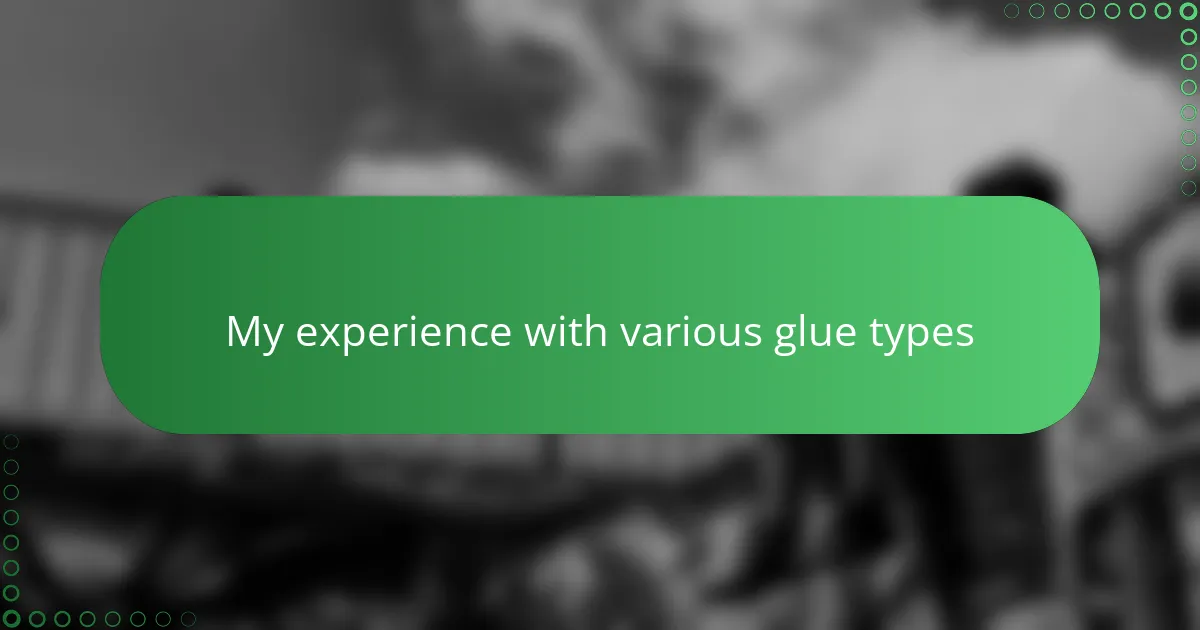Key takeaways
- Choosing the right glue type is essential for preserving the quality of handmade paper crafts, balancing strength and gentleness.
- Testing glue on scrap pieces beforehand can prevent disasters and ensure the right adhesive is used for specific project needs.
- Applying glue sparingly and allowing it to dry properly can enhance the bond quality and prevent damage to delicate papers.
- Maintaining a clean workspace is crucial, as dust or debris can weaken adhesion and affect the overall finish of the project.
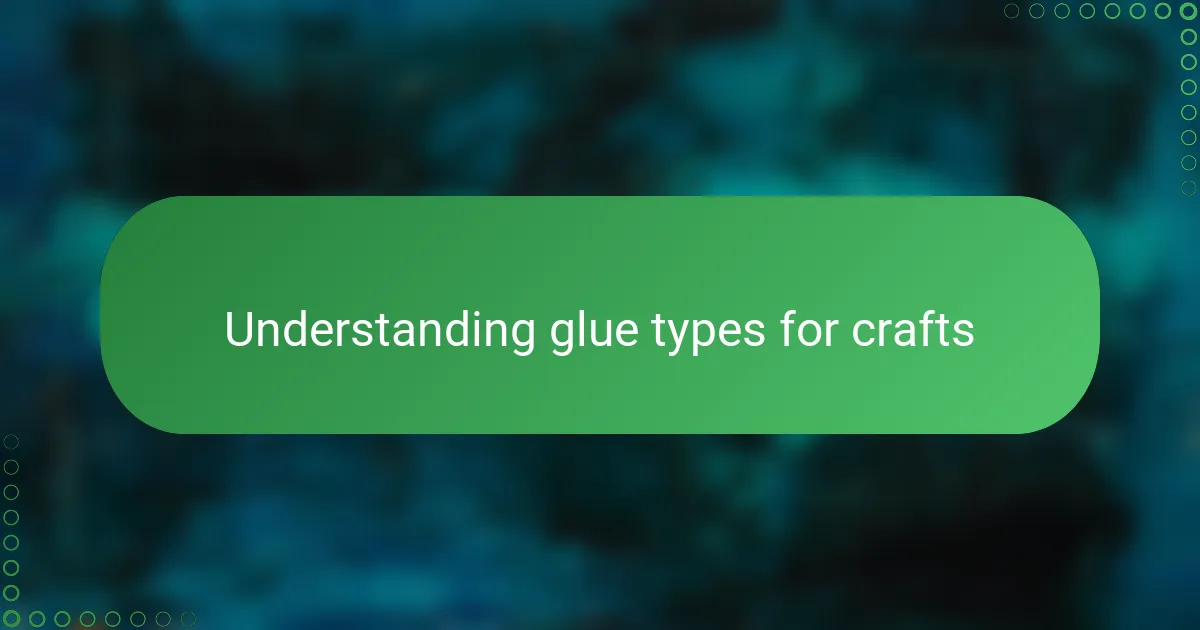
Understanding glue types for crafts
When I first started working on handmade paper crafts, I underestimated how crucial choosing the right glue was. Have you ever tried to fix delicate paper only to end up with wrinkles or discoloration? That’s when I realized that understanding the properties of each glue type makes all the difference.
For example, white craft glue is my go-to for most projects because it dries clear and stays flexible, but it can sometimes take longer to dry than I’d like. On the other hand, super glue offers a quick bond, but I’ve found it can be too harsh for thin handmade papers, causing tears or stiffness. Doesn’t it seem like finding the perfect balance between strength and gentleness is a sort of craft in itself?
Knowing which glue works best for different paper textures and project needs has saved me from frustration many times. I always ask myself: do I need a temporary hold to adjust pieces, or a permanent bond that won’t yellow over time? Answering these questions helps me choose wisely and keeps my paper creations beautiful.
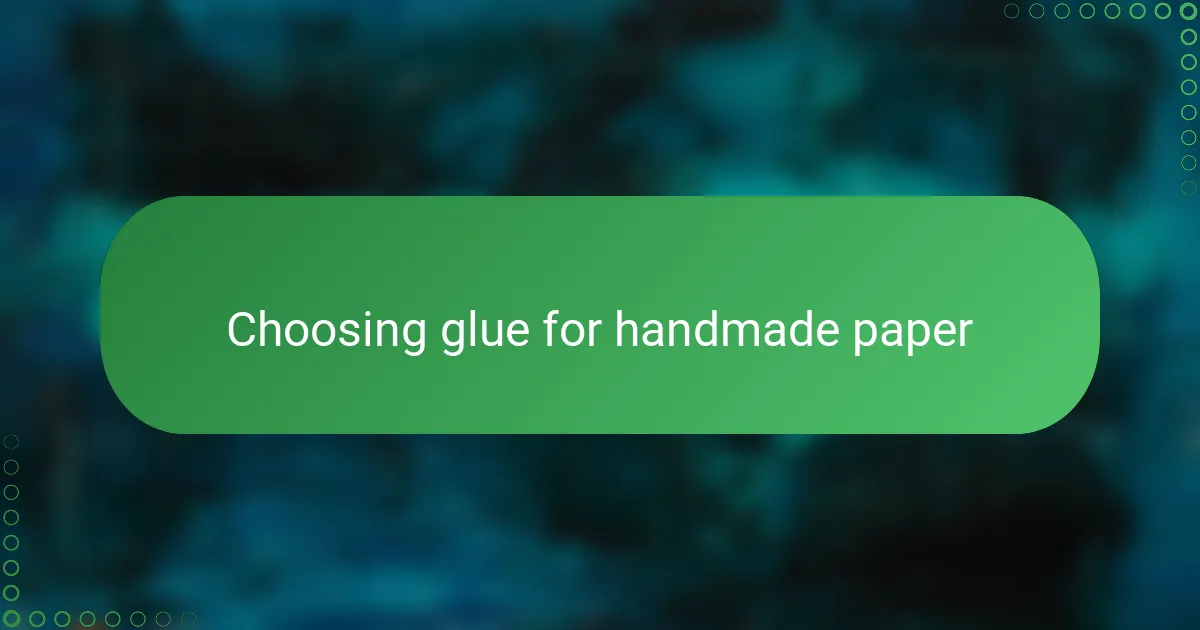
Choosing glue for handmade paper
Choosing glue for handmade paper can feel like navigating a minefield at first. I remember my early attempts when the glue would either soak through the paper or create unsightly lumps. Have you ever noticed how some adhesives react differently on handmade paper compared to store-bought? That delicate texture demands a gentler touch.
From my experience, glue sticks are tempting because they’re mess-free, but they often lack the bonding strength I need, especially for layered projects. I learned the hard way that more isn’t always better; overusing glue can warp the paper and ruin the entire piece. It taught me to apply just enough and let patience do the rest.
I also find it helpful to test my glue choices on small scraps first. This quick step saves me from bigger disasters. Have you tried that? It’s like giving your project a little dress rehearsal before the big performance, and it gives me peace of mind every time.
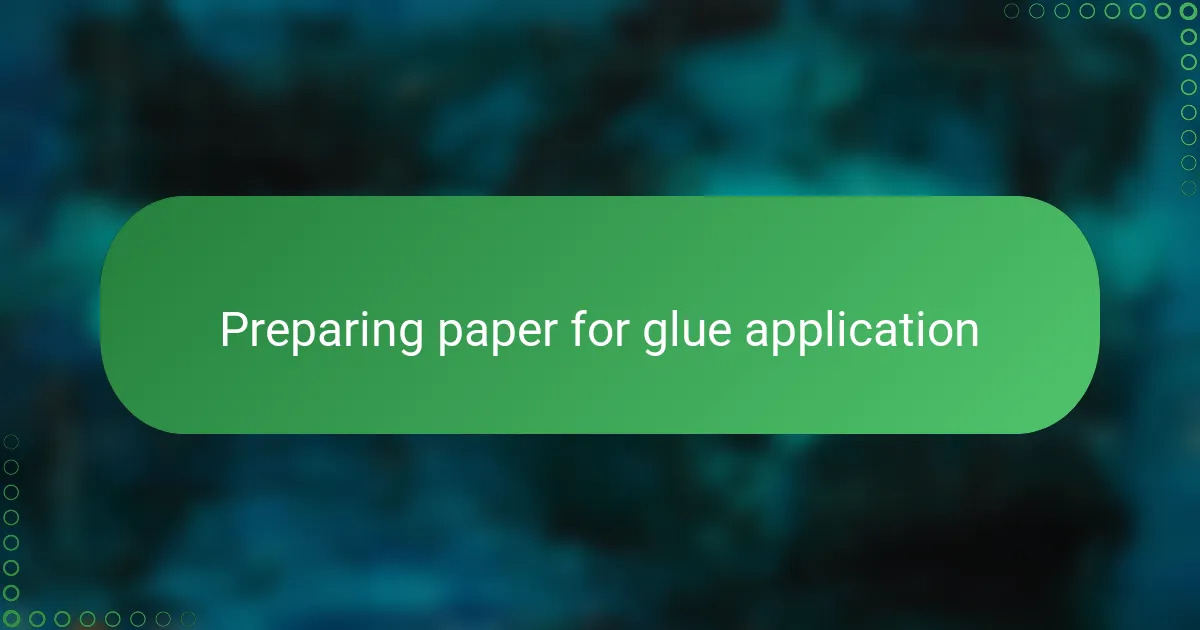
Preparing paper for glue application
Preparing paper for glue application is something I often overlook, but I’ve learned it can make or break my craft. Have you ever noticed how gluing on untreated paper sometimes causes bubbling or uneven adhesion? I now take a moment to gently flatten my handmade sheets and smooth out any wrinkles before I even think about applying glue.
Another step I swear by is lightly misting the paper with water if it feels too dry. It might sound odd, but a little moisture prevents cracking and helps glue absorb evenly. I remember a project where skipping this made my paper stiff and brittle—definitely not the effect I wanted.
Sometimes, I sand the edges very lightly to create a better grip for the glue. It might seem fussy, but this tiny detail gave me stronger bonds, especially on thicker handmade papers. Have you found any little prep tricks that improve your glue jobs? For me, these small habits have saved countless hours of frustration.

Testing glue on paper projects
Testing glue on paper projects has been a real eye-opener for me. I once glued a delicate handmade sheet without a trial, only to watch the edges wrinkle and the color shift—an instant heartbreak. Have you ever felt that sinking feeling when what should be a simple fix turns into a paper disaster?
What changed everything for me was making it a habit to test glues on scrap pieces first. It’s amazing how even a few minutes of experimenting can save hours of frustration later. I ask myself: does this glue dry clear? Does it warp the paper? These little tests give me confidence to move forward without second-guessing.
Sometimes I get surprised by how a glue behaves differently under pressure or layering. For example, super glues that seemed perfect on single layers ended up causing brittleness when used on folded projects. Have you noticed that too? Testing helps me understand these quirks firsthand, and that knowledge has truly elevated my handmade paper crafts.
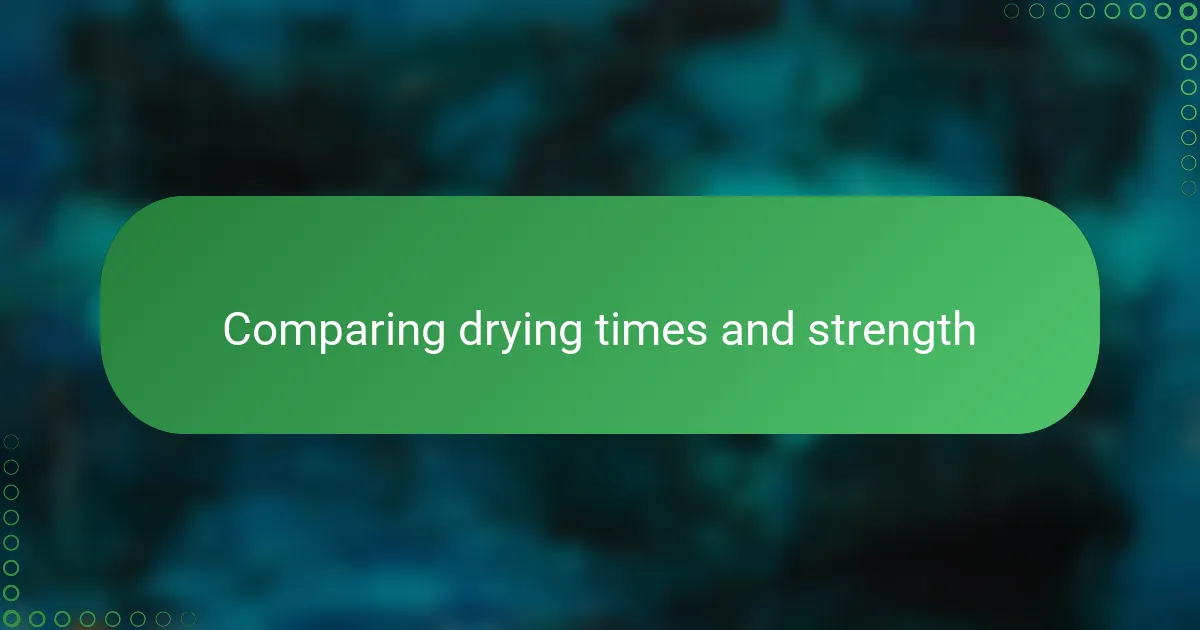
Comparing drying times and strength
When comparing drying times, I’ve noticed that white craft glue takes its sweet time to set, which can be frustrating when I’m eager to move on, but that slow drying often means a stronger, more flexible bond that stands the test of time. Have you ever waited impatiently for glue to dry only to realize that the quick-setting alternatives sometimes sacrifice durability? That patience pays off, especially in delicate paper crafts where strength is crucial.
Strength-wise, super glue was a revelation and a disappointment all at once for me. Its instant bonding impressed me initially, but I quickly learned it can make the paper stiff and brittle, leading to cracks over time. Isn’t it intriguing how what seems like a powerhouse adhesive can actually weaken your creation’s longevity?
On the other hand, glue sticks, though neat and speedy, often left me doubting their hold during layered projects. I found myself doubling up or resorting to other adhesives to reinforce the bond. Have you experienced the letdown of a glued piece falling apart despite all your careful work? Balancing drying speed with lasting strength is really about choosing the right glue for the job—not just the fastest or strongest, but the one that respects the fragility of handmade paper.

Personal results with different glues
My personal experience with white craft glue has been mostly positive—it’s forgiving and gentle on delicate paper, which is such a relief. Yet, I’ve also had moments where patience wore thin waiting for it to dry, especially when I was too eager to see my project come together. Have you found yourself hovering over a freshly glued piece, willing it to set faster?
Super glue, on the other hand, taught me a tough lesson. The first time I used it on a fine handmade sheet, I was amazed by the instant bond—but soon realized it made the paper brittle, causing unsightly cracks. It made me rethink whether strength always means better quality in paper crafting.
Glue sticks seemed like a perfect solution during busy sessions—clean, quick, and easy. However, layering pieces sometimes revealed their weak side, with parts slowly peeling off despite my cautious application. Have you noticed how a seemingly sturdy bond can quietly give way over time? That’s when I learned to combine glues or switch tactics depending on the project’s demands.
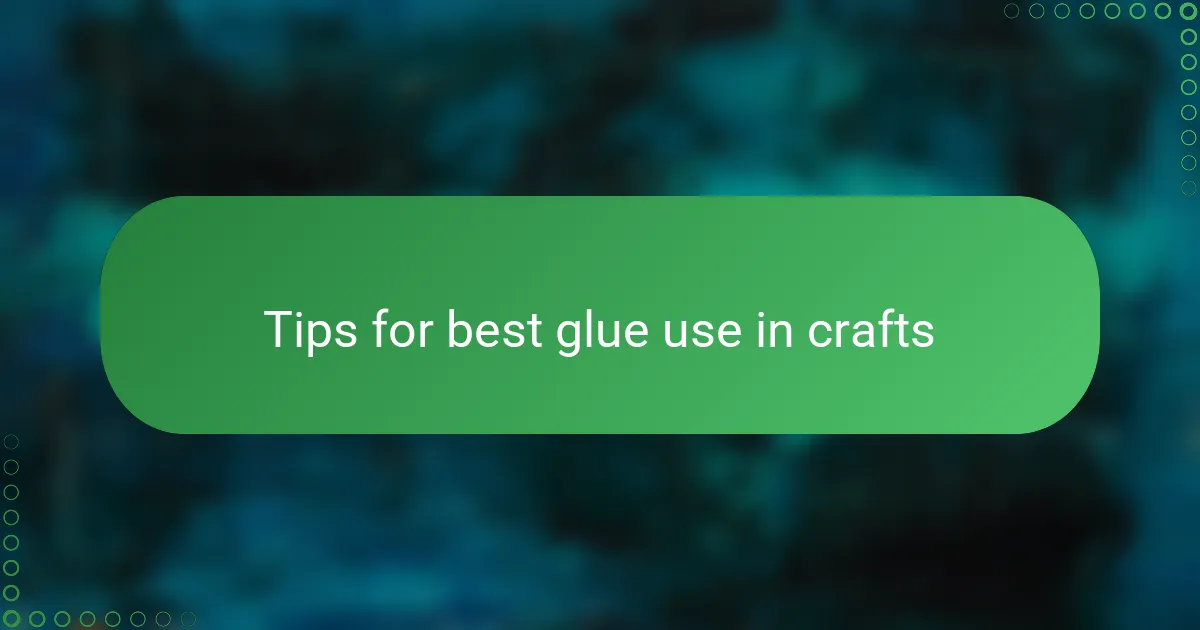
Tips for best glue use in crafts
One tip I always follow is to apply glue sparingly. Early on, I’d get too generous, thinking more glue means a stronger bond, but it usually just leads to soggy, warped paper. Have you ever had a piece buckle under the weight of an overenthusiastic glue application? Trust me, less really is more in preserving that delicate handmade texture.
I also learned that patience is crucial. Rushing to press pieces together before the glue’s ready often causes shifting or wrinkles, which can be so frustrating. Waiting for just the right tackiness before joining surfaces has saved many of my projects from a messy fate. Have you noticed how giving glue time can actually give your craft a smoother finish?
Another trick I swear by is workspace cleanliness. It sounds obvious, but bits of dust or stray fibers under glued areas can weaken bonds or create bumps. I keep a little brush handy to sweep my working area before gluing—this simple habit repeatedly pays off in flawless adhesion. Isn’t it amazing how small habits make a big difference?
